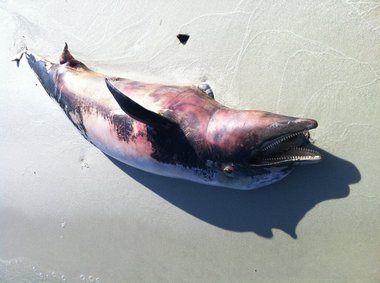You are here
4 Dead Dolphins Wash Up on Gulf Coast Beaches in 5 Days; Deaths Part of 'Unusual Mortality Event'
Primary tabs
by Ben Raines - al.com - October 12, 2011
 Photo - Courtesy of John C. S. Pierce
Photo - Courtesy of John C. S. Pierce
This dolphin was found on the Mobile Bay side of the Fort Morgan peninsula Saturday morning, one of four found since Friday. The death brings the total number of dead dolphins found since the BP oil spill to more than 400. Federal officials say an "Unusual Mortality Event" has been declared for the Gulf's dolphin population, which have been dying at a rate 5 to 10 times higher than average.
DAUPHIN ISLAND, Alabama -- A dolphin carcass, bloated and violet in the morning sun, was found on Fort Morgan early Saturday, bringing the number lost since the BP oil spill to more than 400.
Three other dolphins have washed up in Alabama in the past week, including a pregnant female on Dauphin Island and a mother and calf pair on Hollingers Island in Mobile Bay.
"We should be seeing one (death) a month at this time of year," said Ruth Carmichael, a Dauphin Island Sea Lab scientist tasked with responding to reports of dead dolphins. "We’re getting one or more a week. It’s just never slowed down."
An examination of the Gulfwide death toll, broken down by month, reveals that dolphins continue to die at rates four to 10 times higher than normal. For instance, 23 dolphins were found dead in August, compared to a monthly average of less than 3 each August between 2002 and 2009.
Federal scientists acknowledge they are no closer to solving the mystery behind the "Unusual Mortality Event" that has been sweeping through the Gulf’s dolphin population since March of 2010, one month before BP’s well was unleashed.
But progress has been made, federal officials said, noting that tissue samples are now being sent to various laboratories for analysis. No results have been released.
"We have samples out now, and they’ve been going out for a while," said Jenny Litz, a research biologist with the National Oceanic and Atmospheric Administration. "We still have animals stranding. I would say the event is still unfolding."
Blair Mase, NOAA’s point person for all dolphin strandings in the Gulf, said that reports of dead dolphins have remained stubbornly high, meaning a final report is a long way off. She said that most of the casualties now are adults.
Stillborn or juvenile dolphins made up nearly half of the casualties in February and March this year, but 90 percent of the deaths since then have been adults. Scientists said part of the explanation is simply timing. Dolphins typically calve in the spring, meaning pregnant females and newborns are at their most vulnerable between February and May.
Though many believe a link between the BP oil spill and the elevated death rate seems obvious, dolphins actually began dying a month before the spill.
'Unusual mortality event' for dolphins not unheard of
In March of 2010, 56 dolphins washed ashore in the Gulf, compared to the seven-year average of 16 for the month.
Mass die-offs of dolphins are not unheard of. Fifty-three dolphins washed up on South Carolina beaches this year, and three or four such events typically occur each year around the country.
The majority of the time, the official cause of death is listed as "undetermined," according to federal records.
What’s unusual about what is happening in the Gulf is the duration of the die-off, now well into its second year. It’s possible, scientists said, that whatever killed dolphins in March of 2010 — be it a cold winter, scarce food supplies, or a virus — meant the population was already in a weakened position when the Gulf spill began.
"Clearly, something is going on. My prediction is that it is not going to stop in the near time, if it is what we’re afraid it might be," said Graham Worthy, a University of Central Florida researcher specializing in examining the blubber layer of dolphins and seals to glean information about their health.
"Earlier this year, with the major die-off of the neonates, one of the ideas scientists were throwing around was the disruption of the food chain. Many folks had speculated that was one possible outcome of the spill."
Worthy said such a disruption could weaken the health of the dolphin population on a broad scale, though he cautioned that he has not received any samples from federal officials for analysis.
"I haven’t seen any of these dolphins and don’t know their physical condition. Without tissue samples, all we can do is speculate," Worthy said. "But there have been some interesting stories lately, about abnormalities in developing fish in Louisiana, and reports of the shrimp catch being way, way down this year. Something similar happened after Exxon Valdez, where they had record catches the year after the spill, then a number of species crashed and have never recovered."
Carmichael said the scientific community could do little more than guess about the causes of the deaths until the carcasses have been analyzed.
"We don’t know about lesions on the animals, or about the blubber content. Those are the kinds of analyses we are waiting on," Carmichael said. "When they are done we can work as a group all along the coast and figure out what is going on."
Until that time, all researchers can do is count the bodies as they wash ashore.
http://blog.al.com/live/2011/10/four_dead_dolphins_wash_up_in.html



Recent Comments